Accounting Theory and Accountability
VerifiedAdded on 2022/12/29
|7
|1585
|99
AI Summary
This study material explores the concepts of accounting theory and accountability. It discusses performance indicators for executive bonuses tied to environmental performance and measures of performance related to social issues. The material also highlights the importance of sustainability and stakeholder management.
Contribute Materials
Your contribution can guide someone’s learning journey. Share your
documents today.
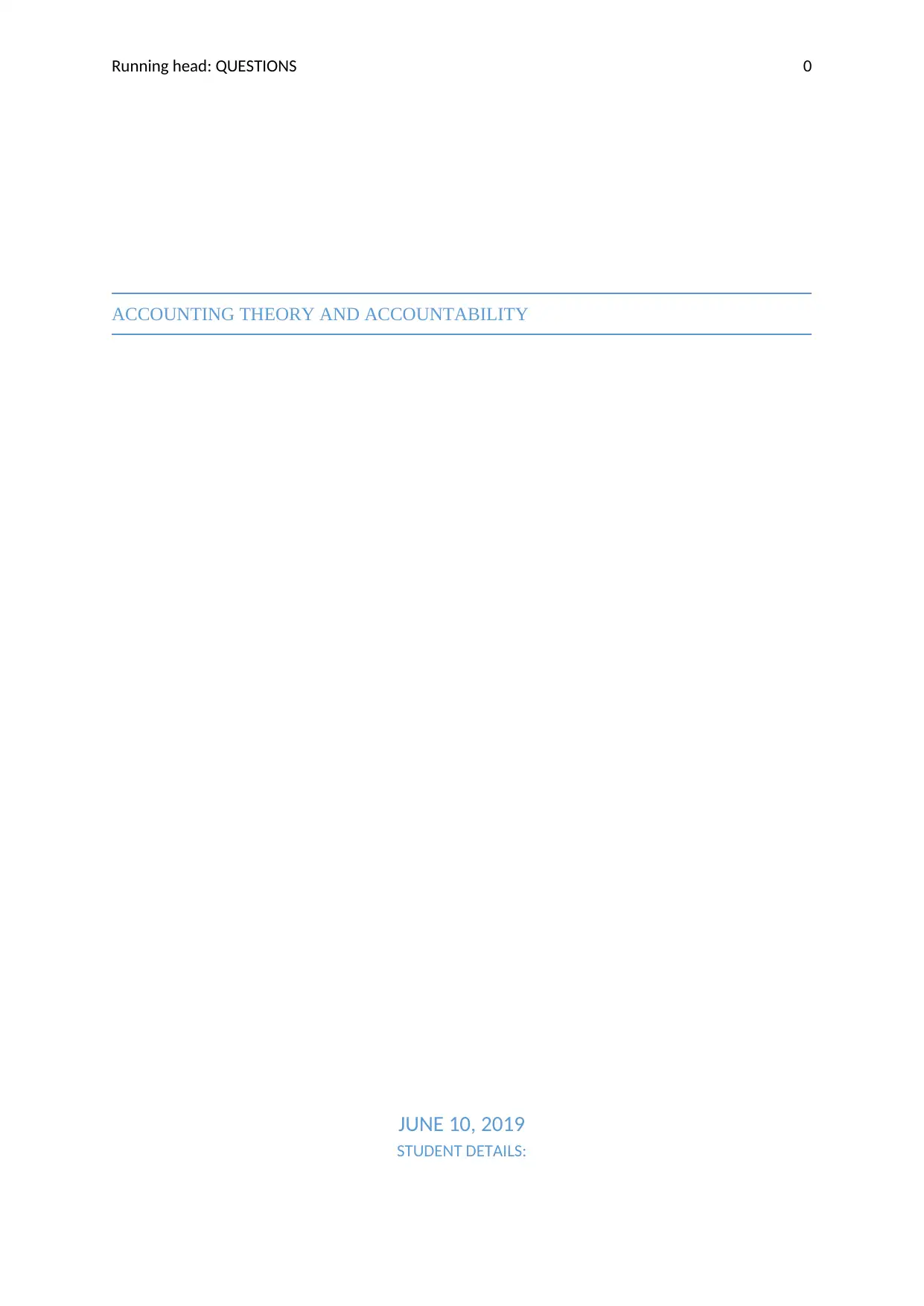
Running head: QUESTIONS 0
ACCOUNTING THEORY AND ACCOUNTABILITY
JUNE 10, 2019
STUDENT DETAILS:
ACCOUNTING THEORY AND ACCOUNTABILITY
JUNE 10, 2019
STUDENT DETAILS:
Secure Best Marks with AI Grader
Need help grading? Try our AI Grader for instant feedback on your assignments.
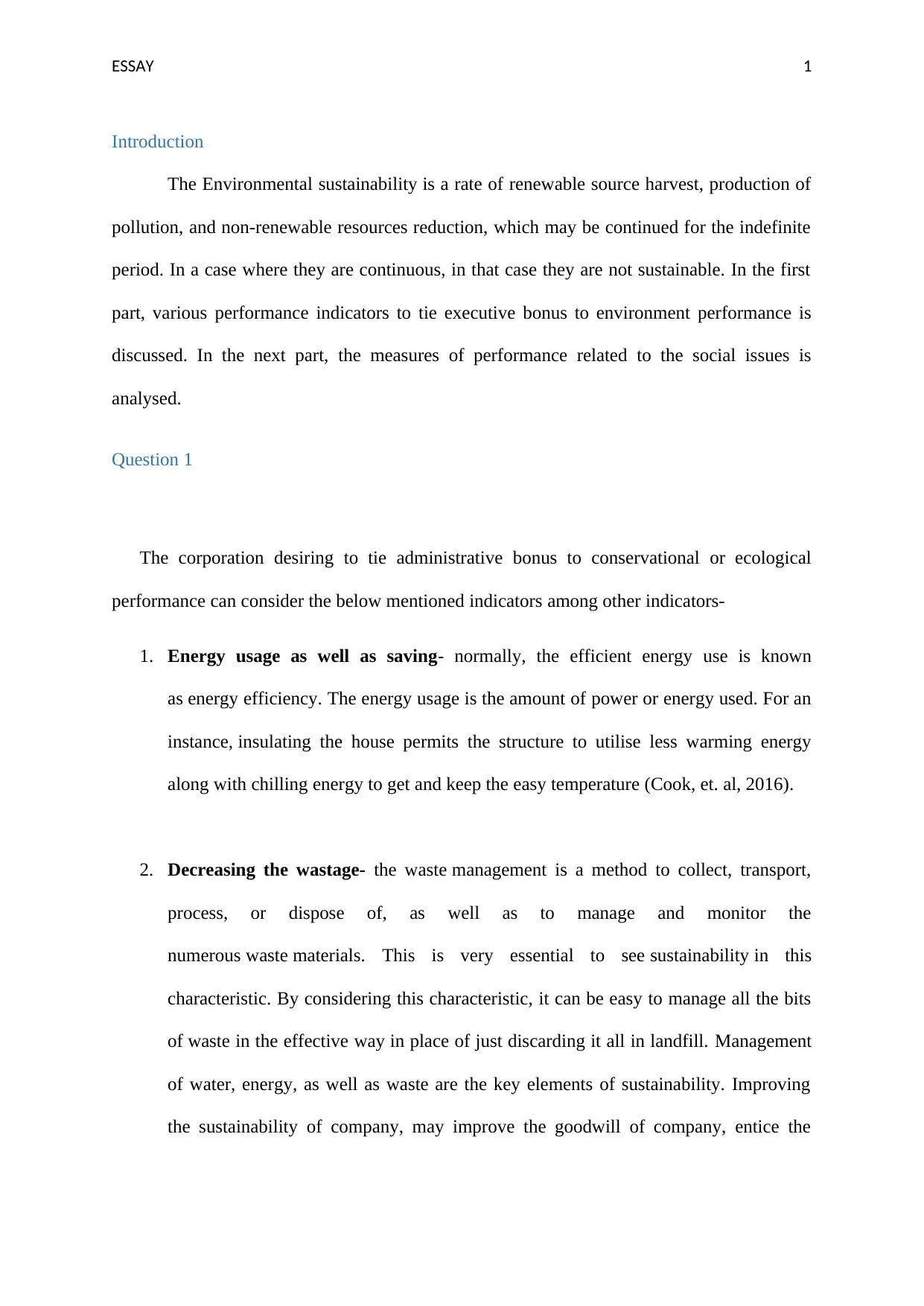
ESSAY 1
Introduction
The Environmental sustainability is a rate of renewable source harvest, production of
pollution, and non-renewable resources reduction, which may be continued for the indefinite
period. In a case where they are continuous, in that case they are not sustainable. In the first
part, various performance indicators to tie executive bonus to environment performance is
discussed. In the next part, the measures of performance related to the social issues is
analysed.
Question 1
The corporation desiring to tie administrative bonus to conservational or ecological
performance can consider the below mentioned indicators among other indicators-
1. Energy usage as well as saving- normally, the efficient energy use is known
as energy efficiency. The energy usage is the amount of power or energy used. For an
instance, insulating the house permits the structure to utilise less warming energy
along with chilling energy to get and keep the easy temperature (Cook, et. al, 2016).
2. Decreasing the wastage- the waste management is a method to collect, transport,
process, or dispose of, as well as to manage and monitor the
numerous waste materials. This is very essential to see sustainability in this
characteristic. By considering this characteristic, it can be easy to manage all the bits
of waste in the effective way in place of just discarding it all in landfill. Management
of water, energy, as well as waste are the key elements of sustainability. Improving
the sustainability of company, may improve the goodwill of company, entice the
Introduction
The Environmental sustainability is a rate of renewable source harvest, production of
pollution, and non-renewable resources reduction, which may be continued for the indefinite
period. In a case where they are continuous, in that case they are not sustainable. In the first
part, various performance indicators to tie executive bonus to environment performance is
discussed. In the next part, the measures of performance related to the social issues is
analysed.
Question 1
The corporation desiring to tie administrative bonus to conservational or ecological
performance can consider the below mentioned indicators among other indicators-
1. Energy usage as well as saving- normally, the efficient energy use is known
as energy efficiency. The energy usage is the amount of power or energy used. For an
instance, insulating the house permits the structure to utilise less warming energy
along with chilling energy to get and keep the easy temperature (Cook, et. al, 2016).
2. Decreasing the wastage- the waste management is a method to collect, transport,
process, or dispose of, as well as to manage and monitor the
numerous waste materials. This is very essential to see sustainability in this
characteristic. By considering this characteristic, it can be easy to manage all the bits
of waste in the effective way in place of just discarding it all in landfill. Management
of water, energy, as well as waste are the key elements of sustainability. Improving
the sustainability of company, may improve the goodwill of company, entice the
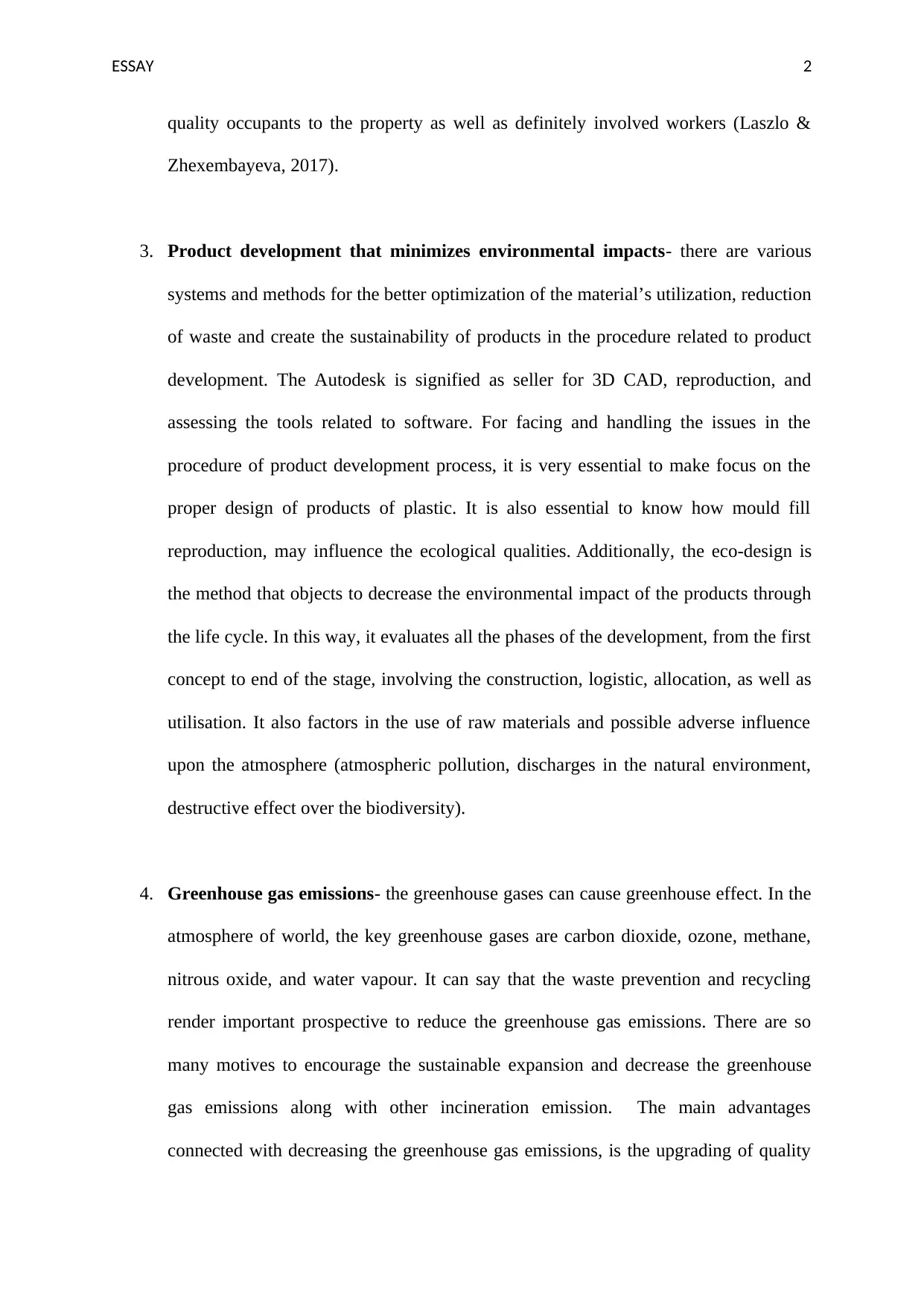
ESSAY 2
quality occupants to the property as well as definitely involved workers (Laszlo &
Zhexembayeva, 2017).
3. Product development that minimizes environmental impacts- there are various
systems and methods for the better optimization of the material’s utilization, reduction
of waste and create the sustainability of products in the procedure related to product
development. The Autodesk is signified as seller for 3D CAD, reproduction, and
assessing the tools related to software. For facing and handling the issues in the
procedure of product development process, it is very essential to make focus on the
proper design of products of plastic. It is also essential to know how mould fill
reproduction, may influence the ecological qualities. Additionally, the eco-design is
the method that objects to decrease the environmental impact of the products through
the life cycle. In this way, it evaluates all the phases of the development, from the first
concept to end of the stage, involving the construction, logistic, allocation, as well as
utilisation. It also factors in the use of raw materials and possible adverse influence
upon the atmosphere (atmospheric pollution, discharges in the natural environment,
destructive effect over the biodiversity).
4. Greenhouse gas emissions- the greenhouse gases can cause greenhouse effect. In the
atmosphere of world, the key greenhouse gases are carbon dioxide, ozone, methane,
nitrous oxide, and water vapour. It can say that the waste prevention and recycling
render important prospective to reduce the greenhouse gas emissions. There are so
many motives to encourage the sustainable expansion and decrease the greenhouse
gas emissions along with other incineration emission. The main advantages
connected with decreasing the greenhouse gas emissions, is the upgrading of quality
quality occupants to the property as well as definitely involved workers (Laszlo &
Zhexembayeva, 2017).
3. Product development that minimizes environmental impacts- there are various
systems and methods for the better optimization of the material’s utilization, reduction
of waste and create the sustainability of products in the procedure related to product
development. The Autodesk is signified as seller for 3D CAD, reproduction, and
assessing the tools related to software. For facing and handling the issues in the
procedure of product development process, it is very essential to make focus on the
proper design of products of plastic. It is also essential to know how mould fill
reproduction, may influence the ecological qualities. Additionally, the eco-design is
the method that objects to decrease the environmental impact of the products through
the life cycle. In this way, it evaluates all the phases of the development, from the first
concept to end of the stage, involving the construction, logistic, allocation, as well as
utilisation. It also factors in the use of raw materials and possible adverse influence
upon the atmosphere (atmospheric pollution, discharges in the natural environment,
destructive effect over the biodiversity).
4. Greenhouse gas emissions- the greenhouse gases can cause greenhouse effect. In the
atmosphere of world, the key greenhouse gases are carbon dioxide, ozone, methane,
nitrous oxide, and water vapour. It can say that the waste prevention and recycling
render important prospective to reduce the greenhouse gas emissions. There are so
many motives to encourage the sustainable expansion and decrease the greenhouse
gas emissions along with other incineration emission. The main advantages
connected with decreasing the greenhouse gas emissions, is the upgrading of quality
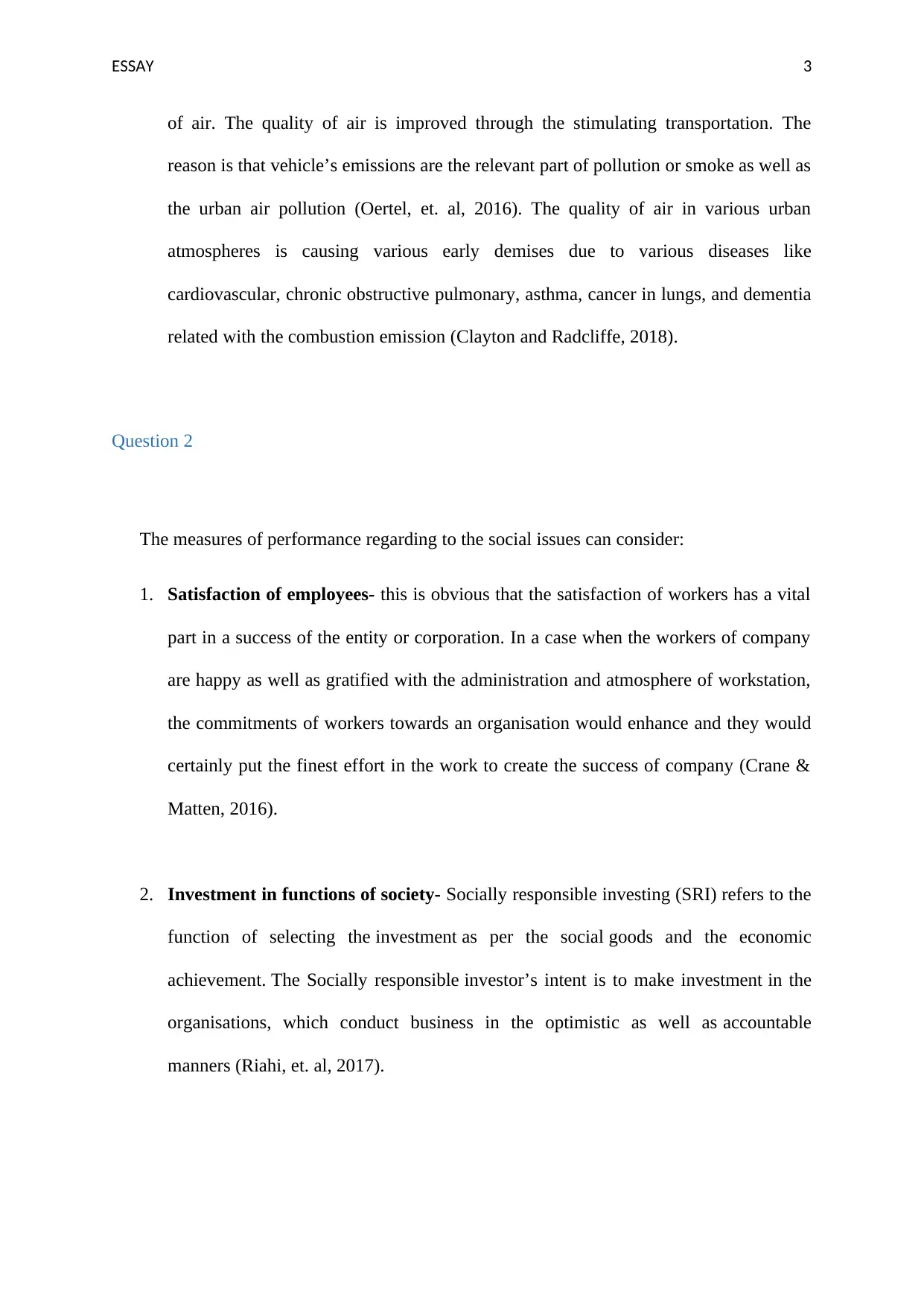
ESSAY 3
of air. The quality of air is improved through the stimulating transportation. The
reason is that vehicle’s emissions are the relevant part of pollution or smoke as well as
the urban air pollution (Oertel, et. al, 2016). The quality of air in various urban
atmospheres is causing various early demises due to various diseases like
cardiovascular, chronic obstructive pulmonary, asthma, cancer in lungs, and dementia
related with the combustion emission (Clayton and Radcliffe, 2018).
Question 2
The measures of performance regarding to the social issues can consider:
1. Satisfaction of employees- this is obvious that the satisfaction of workers has a vital
part in a success of the entity or corporation. In a case when the workers of company
are happy as well as gratified with the administration and atmosphere of workstation,
the commitments of workers towards an organisation would enhance and they would
certainly put the finest effort in the work to create the success of company (Crane &
Matten, 2016).
2. Investment in functions of society- Socially responsible investing (SRI) refers to the
function of selecting the investment as per the social goods and the economic
achievement. The Socially responsible investor’s intent is to make investment in the
organisations, which conduct business in the optimistic as well as accountable
manners (Riahi, et. al, 2017).
of air. The quality of air is improved through the stimulating transportation. The
reason is that vehicle’s emissions are the relevant part of pollution or smoke as well as
the urban air pollution (Oertel, et. al, 2016). The quality of air in various urban
atmospheres is causing various early demises due to various diseases like
cardiovascular, chronic obstructive pulmonary, asthma, cancer in lungs, and dementia
related with the combustion emission (Clayton and Radcliffe, 2018).
Question 2
The measures of performance regarding to the social issues can consider:
1. Satisfaction of employees- this is obvious that the satisfaction of workers has a vital
part in a success of the entity or corporation. In a case when the workers of company
are happy as well as gratified with the administration and atmosphere of workstation,
the commitments of workers towards an organisation would enhance and they would
certainly put the finest effort in the work to create the success of company (Crane &
Matten, 2016).
2. Investment in functions of society- Socially responsible investing (SRI) refers to the
function of selecting the investment as per the social goods and the economic
achievement. The Socially responsible investor’s intent is to make investment in the
organisations, which conduct business in the optimistic as well as accountable
manners (Riahi, et. al, 2017).
Secure Best Marks with AI Grader
Need help grading? Try our AI Grader for instant feedback on your assignments.
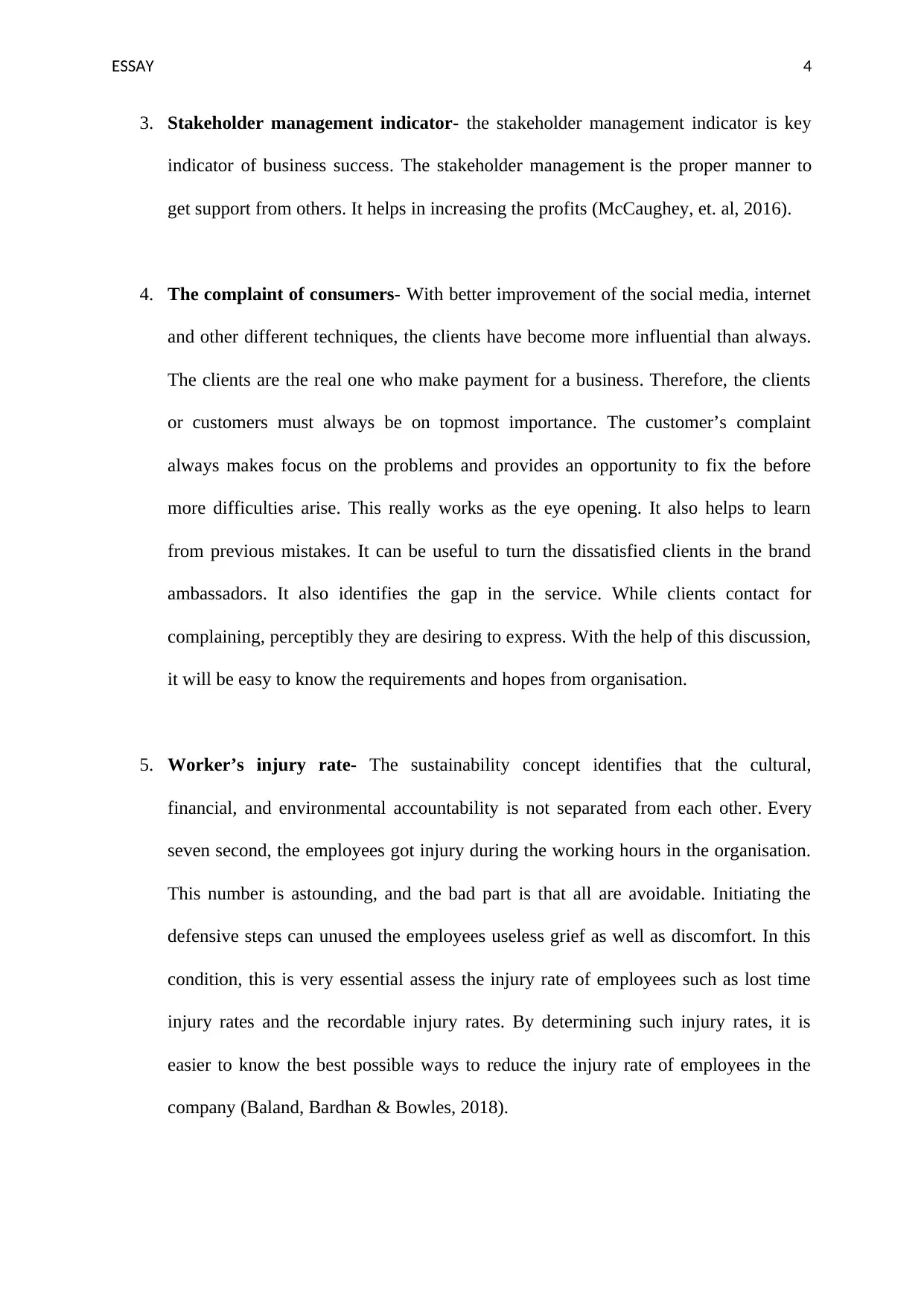
ESSAY 4
3. Stakeholder management indicator- the stakeholder management indicator is key
indicator of business success. The stakeholder management is the proper manner to
get support from others. It helps in increasing the profits (McCaughey, et. al, 2016).
4. The complaint of consumers- With better improvement of the social media, internet
and other different techniques, the clients have become more influential than always.
The clients are the real one who make payment for a business. Therefore, the clients
or customers must always be on topmost importance. The customer’s complaint
always makes focus on the problems and provides an opportunity to fix the before
more difficulties arise. This really works as the eye opening. It also helps to learn
from previous mistakes. It can be useful to turn the dissatisfied clients in the brand
ambassadors. It also identifies the gap in the service. While clients contact for
complaining, perceptibly they are desiring to express. With the help of this discussion,
it will be easy to know the requirements and hopes from organisation.
5. Worker’s injury rate- The sustainability concept identifies that the cultural,
financial, and environmental accountability is not separated from each other. Every
seven second, the employees got injury during the working hours in the organisation.
This number is astounding, and the bad part is that all are avoidable. Initiating the
defensive steps can unused the employees useless grief as well as discomfort. In this
condition, this is very essential assess the injury rate of employees such as lost time
injury rates and the recordable injury rates. By determining such injury rates, it is
easier to know the best possible ways to reduce the injury rate of employees in the
company (Baland, Bardhan & Bowles, 2018).
3. Stakeholder management indicator- the stakeholder management indicator is key
indicator of business success. The stakeholder management is the proper manner to
get support from others. It helps in increasing the profits (McCaughey, et. al, 2016).
4. The complaint of consumers- With better improvement of the social media, internet
and other different techniques, the clients have become more influential than always.
The clients are the real one who make payment for a business. Therefore, the clients
or customers must always be on topmost importance. The customer’s complaint
always makes focus on the problems and provides an opportunity to fix the before
more difficulties arise. This really works as the eye opening. It also helps to learn
from previous mistakes. It can be useful to turn the dissatisfied clients in the brand
ambassadors. It also identifies the gap in the service. While clients contact for
complaining, perceptibly they are desiring to express. With the help of this discussion,
it will be easy to know the requirements and hopes from organisation.
5. Worker’s injury rate- The sustainability concept identifies that the cultural,
financial, and environmental accountability is not separated from each other. Every
seven second, the employees got injury during the working hours in the organisation.
This number is astounding, and the bad part is that all are avoidable. Initiating the
defensive steps can unused the employees useless grief as well as discomfort. In this
condition, this is very essential assess the injury rate of employees such as lost time
injury rates and the recordable injury rates. By determining such injury rates, it is
easier to know the best possible ways to reduce the injury rate of employees in the
company (Baland, Bardhan & Bowles, 2018).
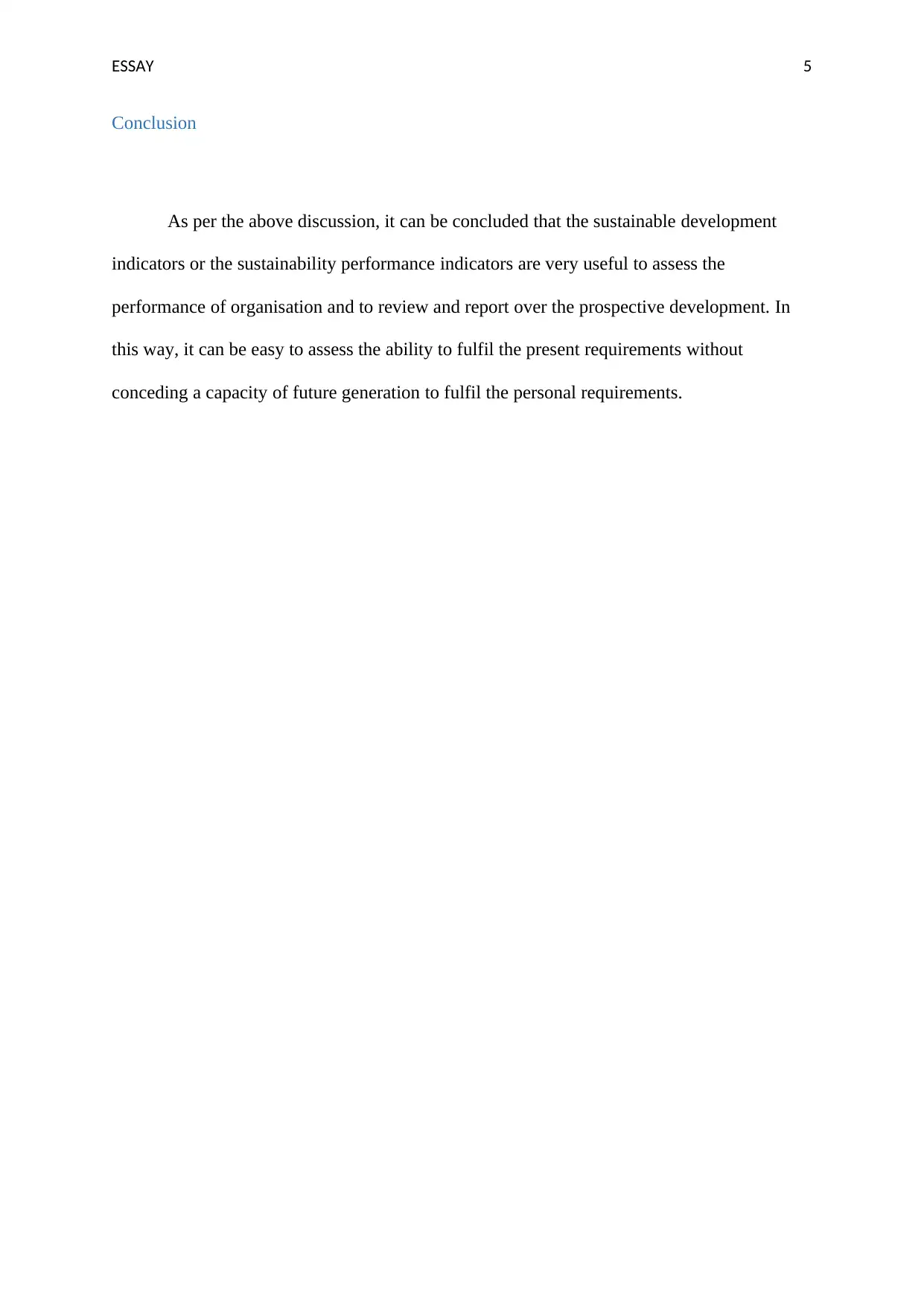
ESSAY 5
Conclusion
As per the above discussion, it can be concluded that the sustainable development
indicators or the sustainability performance indicators are very useful to assess the
performance of organisation and to review and report over the prospective development. In
this way, it can be easy to assess the ability to fulfil the present requirements without
conceding a capacity of future generation to fulfil the personal requirements.
Conclusion
As per the above discussion, it can be concluded that the sustainable development
indicators or the sustainability performance indicators are very useful to assess the
performance of organisation and to review and report over the prospective development. In
this way, it can be easy to assess the ability to fulfil the present requirements without
conceding a capacity of future generation to fulfil the personal requirements.
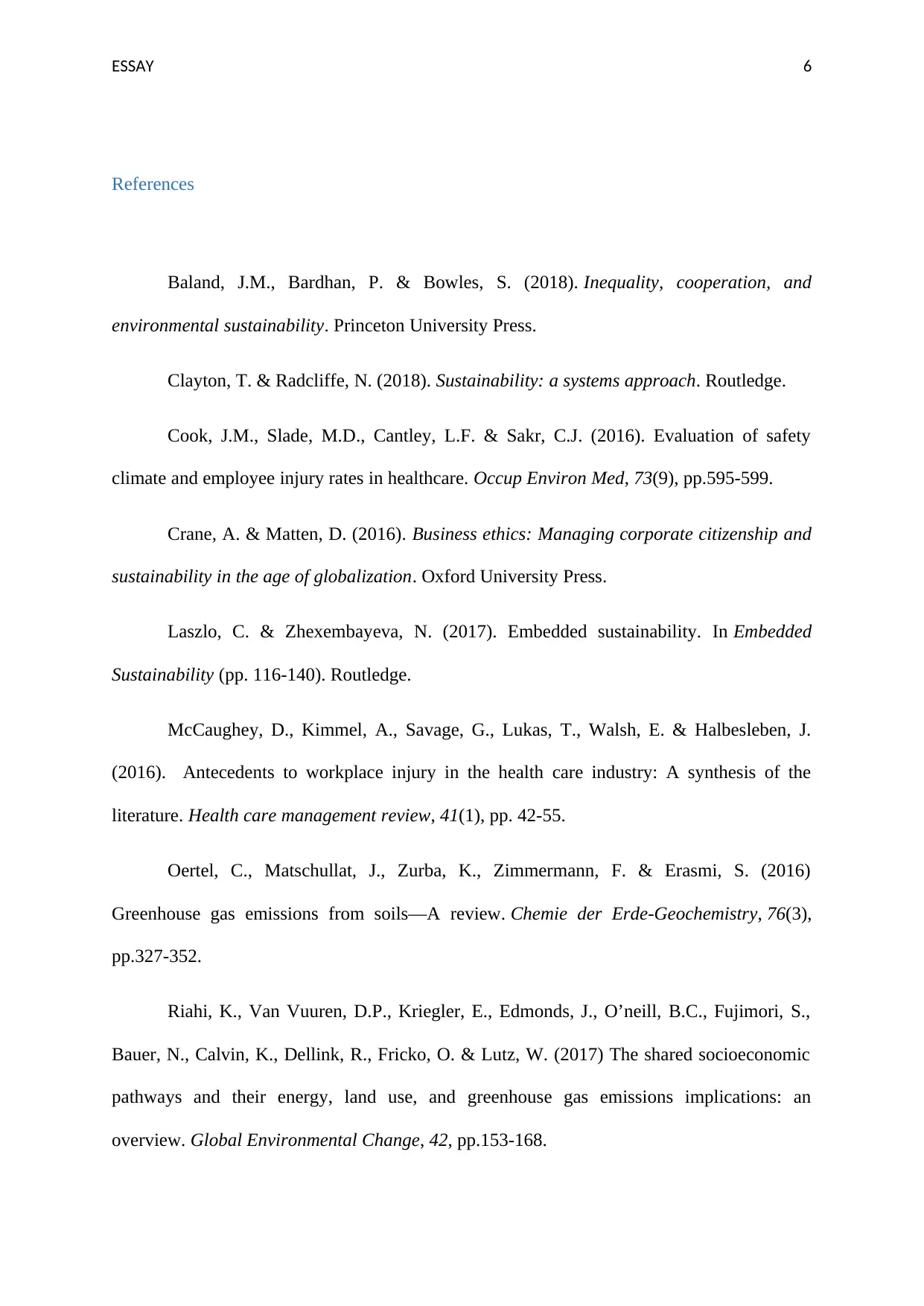
ESSAY 6
References
Baland, J.M., Bardhan, P. & Bowles, S. (2018). Inequality, cooperation, and
environmental sustainability. Princeton University Press.
Clayton, T. & Radcliffe, N. (2018). Sustainability: a systems approach. Routledge.
Cook, J.M., Slade, M.D., Cantley, L.F. & Sakr, C.J. (2016). Evaluation of safety
climate and employee injury rates in healthcare. Occup Environ Med, 73(9), pp.595-599.
Crane, A. & Matten, D. (2016). Business ethics: Managing corporate citizenship and
sustainability in the age of globalization. Oxford University Press.
Laszlo, C. & Zhexembayeva, N. (2017). Embedded sustainability. In Embedded
Sustainability (pp. 116-140). Routledge.
McCaughey, D., Kimmel, A., Savage, G., Lukas, T., Walsh, E. & Halbesleben, J.
(2016). Antecedents to workplace injury in the health care industry: A synthesis of the
literature. Health care management review, 41(1), pp. 42-55.
Oertel, C., Matschullat, J., Zurba, K., Zimmermann, F. & Erasmi, S. (2016)
Greenhouse gas emissions from soils—A review. Chemie der Erde-Geochemistry, 76(3),
pp.327-352.
Riahi, K., Van Vuuren, D.P., Kriegler, E., Edmonds, J., O’neill, B.C., Fujimori, S.,
Bauer, N., Calvin, K., Dellink, R., Fricko, O. & Lutz, W. (2017) The shared socioeconomic
pathways and their energy, land use, and greenhouse gas emissions implications: an
overview. Global Environmental Change, 42, pp.153-168.
References
Baland, J.M., Bardhan, P. & Bowles, S. (2018). Inequality, cooperation, and
environmental sustainability. Princeton University Press.
Clayton, T. & Radcliffe, N. (2018). Sustainability: a systems approach. Routledge.
Cook, J.M., Slade, M.D., Cantley, L.F. & Sakr, C.J. (2016). Evaluation of safety
climate and employee injury rates in healthcare. Occup Environ Med, 73(9), pp.595-599.
Crane, A. & Matten, D. (2016). Business ethics: Managing corporate citizenship and
sustainability in the age of globalization. Oxford University Press.
Laszlo, C. & Zhexembayeva, N. (2017). Embedded sustainability. In Embedded
Sustainability (pp. 116-140). Routledge.
McCaughey, D., Kimmel, A., Savage, G., Lukas, T., Walsh, E. & Halbesleben, J.
(2016). Antecedents to workplace injury in the health care industry: A synthesis of the
literature. Health care management review, 41(1), pp. 42-55.
Oertel, C., Matschullat, J., Zurba, K., Zimmermann, F. & Erasmi, S. (2016)
Greenhouse gas emissions from soils—A review. Chemie der Erde-Geochemistry, 76(3),
pp.327-352.
Riahi, K., Van Vuuren, D.P., Kriegler, E., Edmonds, J., O’neill, B.C., Fujimori, S.,
Bauer, N., Calvin, K., Dellink, R., Fricko, O. & Lutz, W. (2017) The shared socioeconomic
pathways and their energy, land use, and greenhouse gas emissions implications: an
overview. Global Environmental Change, 42, pp.153-168.
1 out of 7
Related Documents
Your All-in-One AI-Powered Toolkit for Academic Success.
+13062052269
info@desklib.com
Available 24*7 on WhatsApp / Email
![[object Object]](/_next/static/media/star-bottom.7253800d.svg)
Unlock your academic potential
© 2024 | Zucol Services PVT LTD | All rights reserved.





